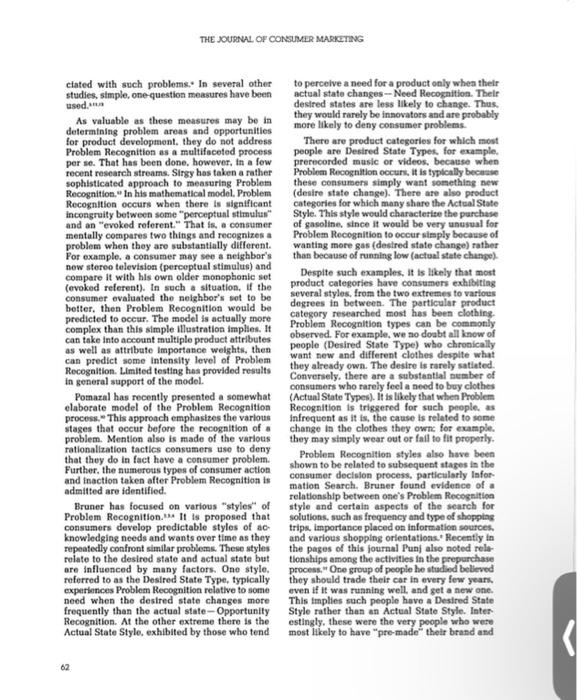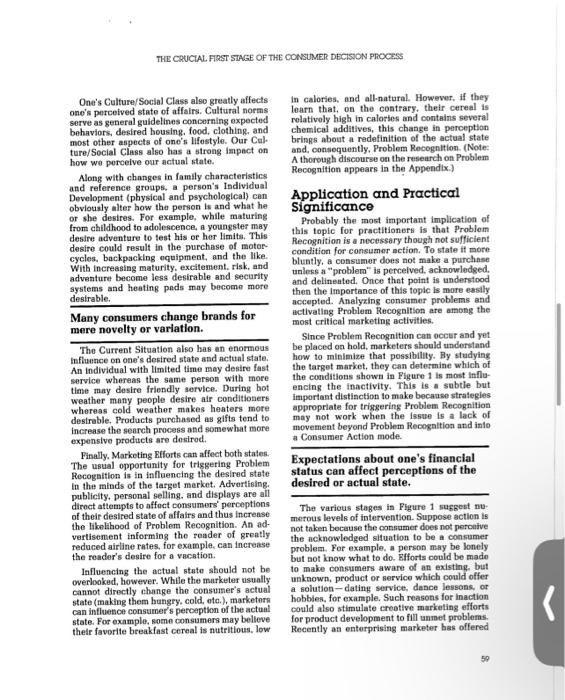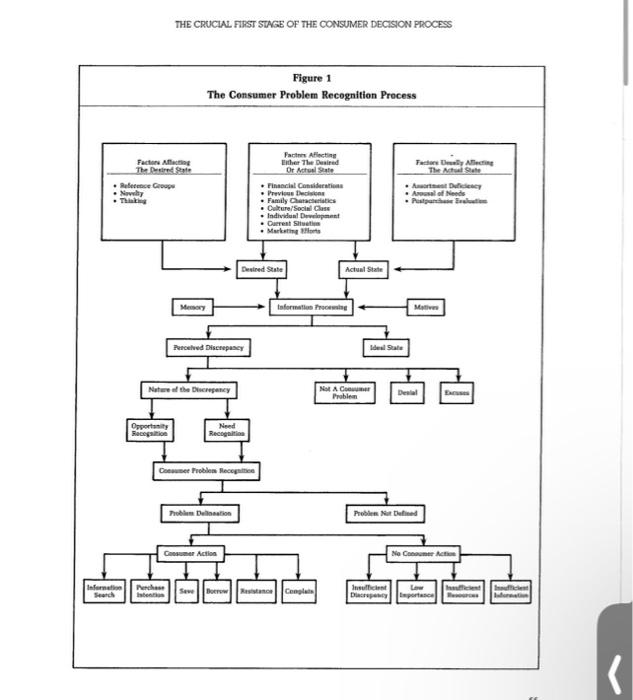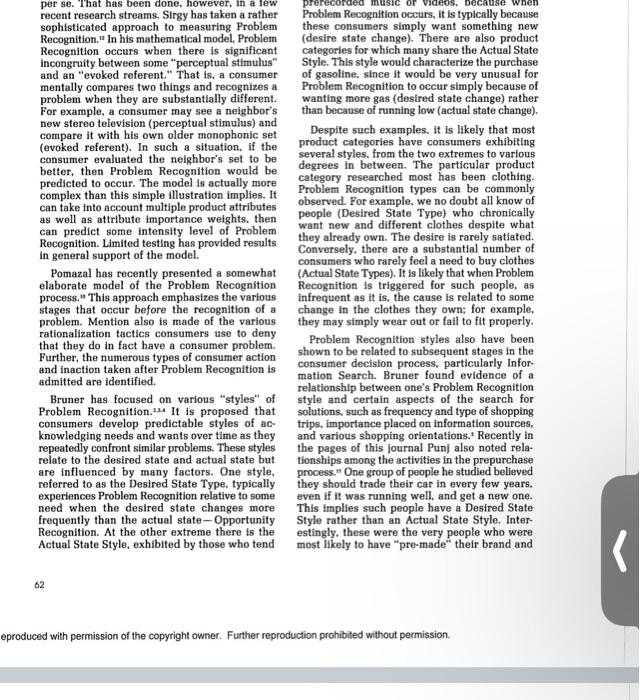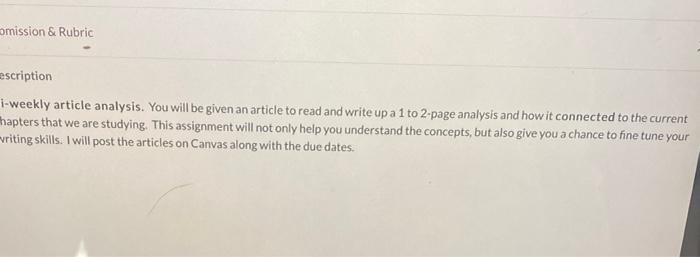https://youtu.be/M7V1a1I5BL0%20
https://youtu.be/ar8S6virCwM
Judging from these readings and videos, what role did loyalty and dedication to ones polis (city-state) played in maintaining a stable society in Athens and Sparta? Although all of these sources were written from the perspective of Athenians, they do provide us with some sense of the value systems that shaped these two societies. In your view, which of these value systems was more likely to maintain a stable polis, and why?
hwlp me cheg took down my answers to this
ciated with such problems. In several other to perceive a need for a product only when thelr studies, simple, one question measures have been actual state changes - Need Recogaition. Thelr used.una desired states are less likely to change. Thus. As valuable as these measures may be in they would rarely be innovators and are probably deteratning problem areas and opportunities more likely to deny consumer problems. for product devolopment, they do not address There are product categeries for which most Problem Recognition as a multifacoted process people are Desired State Types, for example. per se. That has been done, however, in a few prerocorded music or videos, because when recent researeh streams. Sirgy has taken a rather Problom Recognition eccurs, it is typically becanse sophisticated approach to measuring Problet these consumers simply want something new Recognition." In his mathematical model. Problem (deaire state ehange). There are also prodect Recognition occurs when there is uignificant categories for which many share the Actual State incongruity between some "perceptual sttmulus" Style. Thls style weuld characterise the parchase and an "evoked roferent." That is, a consumer of gasoline, since it would be very unusual for mentally compares two things and recognizes a Problem Recognition to occur simply because of problem when they are subatantially different. wanting more gas (deatred state change) rather For example. a consumer may see a neighbor's than because of running low (actual state change). new stereo television (perceptual stimulus) and compare it with his own older monophonic sot Despite such examples, it is likely that most (evoked referent). In such a situation. If the product categories have consumers exhlbitiag consumer evaluated the neighbor's sot to be several styles. Irom the two extremes to various hetter, then Problem Recogaition would be degrees in between. The particular product predicted to oceur. The model is actually more category researched nost has been clothing. complex than this simple illustration implies. It Problem Recognition types can be comnoniy. can take into account multiple product attributes observed. For example, we no doabt all know of as well as attribute Importance weightis, then people (Desired State Type) who chronically can predict some intensity level of Problem want new and different clothes despite what Recogaltion. Limited testing has provided results they already own. The desire is rarely satiated. in general support of the model. Pomazal has recently presented a somsumers who rarely feel a need to bry clothes elaborate model of the Problem. Recognition (Actual State Types). It is likely that when Problem process.- This approach emphasites the various infrequent as it is, the cause is related to some stages that eccur before the recognition of a change in the clothes they own for example. problem. Mention also is made of the various they may simply wear out or fall to fit properly. rationalization tactics consumers use to deny Problea Recognition styles also have been that they do in fact have a consumer problem. shown to be related to subsequent atages in the Further, the numerous types of consumer action consumer decislon process, particulsrly laforadnitted are identified. mation Search. Bruner found evidence of a Bruner has focused on various "styles" of relationship between one's Problem Recognition Problem Recegnition.us it tstyle and certain aspects of the search for: Problem Recognition. sa it is proposed that solutions, such as frequency and type of shopplang consumers develop predictable styles of ac- trips. importance placed on information sources. knowledging needs and wants over time as they and various shoppling orlentations' Recently in repeatedly confront similar problems. These styles the pages of this journal Punj also noted relaroiate to the desired state and actual state but tionships among the activities in the prepurchase are influenced by many factors. One style, process." One group of people he utadied belleved roforred to as the Desired State Type, typically thoy should trade their car in every few years. experbances Problem Recognition relative to some even if it was running weil, and get a new one. need when the desired state changes more This implies such people have a Desired State frequently than the actual state-Opportunity Style rather than an Actual State Style. Inter: Recognition. At the other extreme there is the estingly, these were the very people who wete Actual State Style, exhibited by those who tend most likely to have "pre-made" their brand and THE JOUREAL OF COAEOMER MANGATIG "clean" urine samples for people with potential In some instances, loans and savings plans problems arising from random drug testing. can be offered for people lacking financial If no action is taken because the consumer resources. (while personally admitting to a problem) will not publicly acknowledge or admit that a problem exists, then efforts need to be taken to overcome People possess the unique capacity such denial tactics. Mere excuses could be to think, plan, and anticipate events directly dealt with if the consumer can be totally unrelated to their current state persuaded to reveal the real objections. Some of affairs. consumers maly need help with delineating the exact nature of their problem. Efforts could be made to encourage self-exploration as to exactly what "the problem" might be. If no action has been taken because the prob- If no action has been taken because the not personally relevant. then proper strategies discrepancy between the two states is small. are harder to come by. In essence, it is a matter then efforts can be focused on widening the of changing what is important to them. and doing gap. This could be done by promotional efforts s0 can be rather difficult to accomplish, especially to increase perceptions of the desired state, in the short run. decrease perceptions of the actual state, or both. Finally. If it is determined that no action was Cultural norms serve as general taken because of Insufficient Information on guidelines concerning expected the part of the consumer, the obvious solution is behaviors, desired housing, food, A marketer must also decide whether to initiate clothing, and most other aspects of generic or selective Problem Recognition. In most. one's lifestyle. stituations, selective Problem Recognition is be As was discussed enrlier, a problem may also preferred so that the consumer seeks out a be put on hold beceuse the consumer lacks the particular brand in preference to others. However. resources necessary to advance toward resolutlon- there are occasions when triggering generic che been done most admirably of late by the raisin to influence directly a consumer's financial status. producers. They have successfully turned around However, by sccurately anticipating or roacting the decline of sales of raisins with their "I Heard to changes in the financial situation of a market It Through the Grapevine" campaign. segment, the marketer can make sizable profits. When one considers the task of activating For example, the financial changes of unemployed Problem Recogaition, the Issue of style takes on workers in a community may open up new particular relevance. For Instance, if a target marketing mix opportunities for job training market is composed predominantly of Desired courses, leisure time activities, or even public State Types (see the Appondix), then rolying on service. Reseanch could also determine what appeals to the Novelty motivation and showing specific resource, other than money, is lacking, others from relevant Reference Groups using and efforts could then be made to minimire that the product should be effective. "cost" to the target market. For example, Plzza Hut found If was not able to capitalize on the Unfortunately, such appeals are not likely to growing lunch business because many people work well for Actual State Types. In fact, it may did not have the time necessary to wait for a be difficult to appeal to them at all. However. If plzza to be made. By adjusting their plzza they are already ownerg of a product, then preparation process, they were able to guarantee showing new uses could get them to use it up an order in just five minutes. Thus, their strategy more quickly, thereby bringing on Problem was not to trigger Problem Recognition - it had Recognition more frequently. Actual State Types already been triggered - but to help potential might even be sensitive to appeals that tap into customers minimize the resources necessary to thelr desire to "make do," "stretch a penny," solve the problem. and get a bargaln. THE CRUCIAL FIST STAGE OF THE CONSUMER DECISION PROCESS One's Culture/Social Class also greatly affects in calories, and all-natural. However, if they one's perceived state of affairs. Cultural norms learn that, on the contrary, their cereal is serve as general guldelines concerning expected rolativoly high in calories and contains several behaviors, desired bousing. food, clothing, and chemlcal additives, this change in perception most other aspects of one's lifostyle. Our Cul. brings about a radefinition of the actual state ture/Social Class also has a strong impect on and, consequently, Problem Rocognition. (Note: how we porceive our actual state. A thorough discourse on the research on Problem Along with changes in family characteristics and reference groups, a person's Individual Development (physical and psychological) can obviously alter how the person ts and what he or she desires. For example, while maturing Recognition appears in the Appendix.) from childhood to adolescence, a youngster may desire adventure to test his or her limits. This desire could result in the purchase of motorcycles, backpacking equipment, and the like. With increasing maturity, excitement. risk, and adventure become less desirable and security unless a "problem" is percelved. acknowledged. systems and heating pads may become more and delineated. Once that point is understood desirable. then the importance of this topic is more easily Many consumers change brands for accepted. Analyzing consumer problems and mere novelty or variation. most critical marketing activities. The Current Situation also has an enormous be placed on hold, marketers should understand influence on one's desired state and actual state. how to minimize that possibility. By studying An individual with limited time may desire fast the target market, they can determine which of service whereas the same person with more the conditions shown in Figure 1 is most influtime may desire friendlly service. During bot encing the inactivity. This is a sabtle but weather many people desire air conditioners important distinction to make because strategies whereas cold weather makes heaters more appropriate for triggering Problem Recognition desirable. Products purchased as gifts tend to may not work when the issue is a lack of increase the search process and somewhat more movement beyond Problem Recognition and into expensive products are desirod. Finelly. Marketing Elforts can affect both states. The usual opportunity for trisgering Problem Recogaition is in influencing the desired state a Consumer Action mode. In the minds of the target merket. Advertising. publicity. personal selling. and displays are all diroct attempts to affact consumers' perceptions of their desired state of affairs and thus incrense various stages in Flgure 1 suggest nu- the likelihood of Problem Recognition. An ad- merous levels of intervention. Suppose action is vertisement informing the. not taken because the connamer does not peronive reduced airtise the acknowledged situation to be a conrumer the reader's rates, for example, can increase problem. For example, a person may be lonely but sot know what to do. Bfforts could be made lafluencing the actual state should not be to make consumers aware of an existing. but overlooked, however. Whlle the marketer usually unknown, product or service which could offer cannot directly change the consumer's actual a solution-dating service, dence lessons, or state (making them hungry, cold, oto.), marketern hobbles, for example. Such reasons for inaction can influence consumer's perception of the actual could also stimulate creotive marketing efforts state. For example, some consumers may belleve for product development to fill unset problems. their favorite breakiast cereal is nutritious, low Recently an enterprising marketer bas offered recent research streams. Sirgy has taken a rather Problem Recognition occurs, it is typlcally because sophisticated approach to measuring Problem these consumers simply want something new Recognition," In his mathematical model, Problem (desire state change). There are also product Recognition occurs when there is significant categories for which many share the Actual State incongruity between some "perceptual stimulus" Style. Thls style would characterize the purchase and an "evoked referent." That is, a consumer of gasoline, since it would be very unusual for mentally compares two things and recognizes a Problem Recognition to occur simply because of problem when they are substantlally different. Wanting more gas (desired state change) rather For example, a consumer may see a neighbor's than because of running low (actual state change). new stereo television (perceptual stimulus) and compare it with his own older monophonic set Despite such examples. it is likely that most (evoked referent). In such a situation, if the product categories have consumers exhibiting consumer evaluated the neighbor's set to be several styles, from the two extremes to various better, then Problem Recognition would be degrees in between. The perticular product predicted to occur. The model is actually more category researched most has been clothing. complex than this simple illustration implies. It Problem Recognition types can be commonly can take into account multiple product attributes observed. For example, we no doubt all know of as well as attribute importance weights, then people (Desired State Type) who chronically can predict some intensity level of Problem want new and different clothes despite what Recognition. Limited testing has provided results they already own. The desire is rarely satiated. in general support of the model. Conversely, there are a substantlal number of consumers who rarely feel a need to buy clothes Pomazal has recently presented a somewhat (Actual State Types). It is likely that when Problem elaborate model of the Problem Recognition Recognition is triggered for such people, as process." This approach emphasizes the various infrequent as it is, the cause is related to some stages that occur before the recognition of a change in the clothes they own: for example. problem. Mention also is made of the various they may simply wear out or fail to fit properly. rationalization tactics consumers use to deny Problem Recognition styles also have been that they do in fact have a consumer problem. shown to be related to subsequent stages in the Further, the numerous types of consumer action consumer decision process, particularly Inforand inaction taken after Problem Recognition is mation Search. Bruner found evidence of a admitted are identified. relationship between one's Problem Recognition Bruner has focused on various "styles" of style and certain aspects of the search for Problem Recognition. 3.4 It is proposed that solutions, such as frequency and type of shopping consumers develop predictable styles of ac- trips, importance placed on information sources, knowledging needs and wants over time as they and various shopping orientations. 2 Recently in repeatedly confront similar problems. These styles the pages of this journal Punj also noted relarelate to the desired state and actual state but tionships among the activities in the prepurchase are influenced by many factors. One style, process." One group of people he studied believed referred to as the Desired State Type, typically they should trade their car in every few years, experiences Problem Recognition relative to some even if it was running well, and get a new one. need when the desired state changes more This implies such people have a Desired State frequently than the actual state-Opportunity Style rather than an Actual State Style. InterRecognition. At the other extreme there is the estingly, these were the very people who were Actual State Style, exhibited by those who tend most likely to have "pre-made" their brand and 62 eproduced with permission of the copyright owner. Further reproduction prohibited without permission. ascription i-weekly article analysis. You will be given an article to read and write up a 1 to 2-page analysis and how it connected to the current napters that we are studying. This assignment will not only help you understand the concepts, but also give you a chance to fine tune your riting skills. I will post the articles on Canvas along with the due dates
